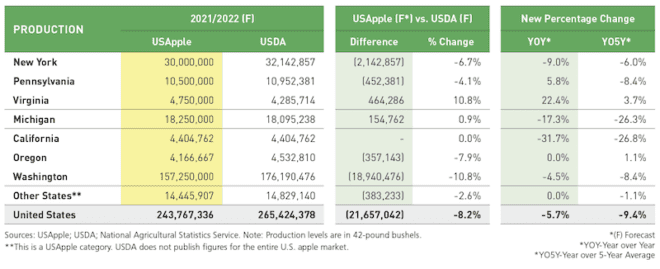

Aug 30, 2021USApple: 244M bushels, down 5.7%
Total U.S. Apple Association production estimate for 2021-2022: 243.7 million bushels.
If the crop hits that number, it would be down 5.7% from last year, 9.4% from the five-year average. The association’s estimate came in 8.2% below the USDA’s prediction of 265.4 million bushels (fresh, processing and non-sold).
The announcement concluded the 126th annual USApple Outlook Conference, held in-person with more than 230 participants in Chicago, Aug. 18-19.
The New York apple crop (30 million, 42-pound bushels) is expected to be off by 9% from last year and down 6% from the five-year average. Pennsylvania’s crop (10.5 million) is projected to be down 5.8% from a year ago and 8.4% from the five-year average. Virginia (4.75 million) comes in 22.4% below 2020 and 3.7% from the five-year average.
In Michigan, the crop (18.25 million) is forecast to decline 17.3% from a year ago and down 26.3% from last year.
California’s crop (4.4 million) will be down 31.7% from 2020 and should decline 26.8% over the five-year average.
Oregon (4.1 million) is slated to remain steady with a 1.1% dip over the five-year average.
Washington state (157.3 million), the biggest producer in the U.S., should come in 4.5% below a year ago and 8.4% under the five-year average.
USApple estimates the remaining apple-producing states will produce 14.4 million bushels, about even with the previous year and a 1.1% dip on the five-year average.
The USDA does not publish figures for the entire U.S. apple market.
While the COVID-19 pandemic has tested the apple industry up and down the supply chain, it has also presented unique opportunities, according to a new report released during the Outlook event by the U.S. Apple Association.
Considering these opportunities, and despite a challenging 18 months, apple production is expected to exceed 11 billion pounds this crop year.
USApple’s “Industry Outlook 2021” provides the most up-to-date data and analysis on U.S. and global apple production, utilization and trade. Authored by USApple Director of Industry Analytics Chris Gerlach, the report takes an in-depth look at the many trends and forces – from H-2A labor issues to online grocery shopping – helping to shape the U.S. apple industry.
Production
According to a USApple analysis of USDA data, total U.S. apple production for the 2021-22 crop year will exceed 11.1 billion pounds or 265.4 million bushels. This represents a 2.7% increase compared to 2020-21 crop year production of 258.6 million bushels and is 1.3% less than the five-year production average.


Gerlach noted that these figures are more comprehensive than USDA data, which only looks at the top seven apple-producing states.
“We’ve analyzed the production from states outside of the top seven and added that back to USDA’s figure,” Gerlach said.
At the varietal level, Gala is expected to retain the top spot with almost 49.3 million bushels produced, accounting for around 19% of the U.S. apple market. Rounding out the top five are Red Delicious (35.7 m bu), Honeycrisp (31 m bu), Fuji (29.1 m bu) and Granny Smith (27.2 m bu). In comparison, the 2020 top five produced apple varieties were: 1) Gala, 2) Red Delicious, 3) Fuji, 4) Honeycrisp and 5) Granny Smith.
Trade
With respect to fresh apple imports and exports, the U.S. still retains a healthy positive trade balance. In the 2020-21 crop year. the U.S. exported almost 41 million bushels of fresh apples while only importing around 5.2 million bushels. These net exports (35.6 m bu) are valued at almost $773.8 million
“On a year-over-year basis, while the balance of trade has declined with respect to quantity, it has increased in value,” said Gerlach. “This is primarily being caused by a rapid decline in the value of imports from the 2019-20 crop year, but is also due to some resilience in export values which have not decreased as much relative to export quantities.”
China, the top global producer of apples, will produce about 2.3 billion bushels of apples in 2021. European countries will produce about 616 million bushels, while South America (mostly Argentina, Chile and Brazil) will produce 160 million bushels. Canada will produce 18.8 million bushels, according to USApple.
China
“Any assessment of the U.S. apple industry must consider the agricultural employment situation,” said Gerlach. “We are losing domestic workers faster than we can replace them and so, increasingly, growers have had to turn to seasonal migrant labor, or H-2A workers, to meet their needs.”
This is a critical issue for the U.S. apple industry because this source of labor is expensive and getting more so. In the Pacific Northwest, for example, the Adverse Effect Wage Rate (AEWR), the minimum compensation rate for H-2A labor, has been increasing by more than 5% annually for the last 10 years.
From 2014 to 2020, average annual crop production employment fell by 3% and, in apple orchards specifically, it declined by 20%.
Consumer Trends
“Fortunately, throughout the disruptions brought on by COVID-19, the U.S. apple industry has not seen any considerable decrease in domestic demand,” said Gerlach.
Throughout the pandemic, apple packers and marketers have been quick to respond by offering bagged apples that give consumers added peace of mind by reducing the handling needed to stock and pick the fruit. Also, Gerlach said, the most significant consumer trend to come out of the pandemic was the rate at which shoppers embraced e-commerce grocery shopping, which also aided the sale of apples. By the first quarter of 2021, e-commerce had grown to account for 3.5% of food and beverage store sales at $6.9 billion (up from $1.5 billion in Q1 of 2018 – an increase of more than 377%).
“All of these external forces, from labor costs to consumer grocery trends, will continue to shape apple production and utilization throughout the coming years,” said Gerlach.
— Gary Pullano, managing editor















